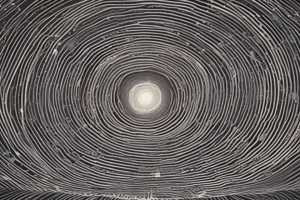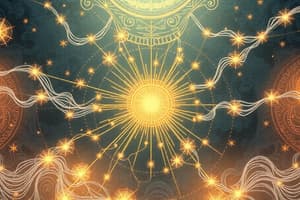Podcast
Questions and Answers
Quelle est l'unité du champ magnétique dans le système international (SI) ?
Quelle est l'unité du champ magnétique dans le système international (SI) ?
- Gauss
- Ampère
- Tesla (correct)
- Volts
Qu'est-ce qui induit un champ magnétique selon les lois étudiées ?
Qu'est-ce qui induit un champ magnétique selon les lois étudiées ?
- Une intensité I dans un fil (correct)
- Une chaleur élevée
- Un champ électrique alternatif
- Une charge stationnaire
Quelle est la force expérimentée par une charge en mouvement dans un champ magnétique ?
Quelle est la force expérimentée par une charge en mouvement dans un champ magnétique ?
- Force de Lorentz (correct)
- Force de Coulomb
- Force gravitationnelle
- Force centrifuge
Dans le cas d'une spire circulaire, quelle caractéristique est mise en avant ?
Dans le cas d'une spire circulaire, quelle caractéristique est mise en avant ?
Quel type de matériaux est décrit comme naturellement aimanté ?
Quel type de matériaux est décrit comme naturellement aimanté ?
Que représente une ligne de champ magnétique ?
Que représente une ligne de champ magnétique ?
Comment orienter le champ magnétique en utilisant la main ?
Comment orienter le champ magnétique en utilisant la main ?
Quelle est la caractéristique d'un solénoïde ?
Quelle est la caractéristique d'un solénoïde ?
Quel noyau est le plus couramment utilisé en RMN en raison de sa simplicité ?
Quel noyau est le plus couramment utilisé en RMN en raison de sa simplicité ?
Quel est le condition nécessaire pour qu'un noyau puisse être utilisé en RMN ?
Quel est le condition nécessaire pour qu'un noyau puisse être utilisé en RMN ?
Que se passe-t-il lorsque le champ magnétique extérieur est égal à 0 ?
Que se passe-t-il lorsque le champ magnétique extérieur est égal à 0 ?
Quel terme désigne le mouvement autour de l'axe B0 des spins sous un champ magnétique ?
Quel terme désigne le mouvement autour de l'axe B0 des spins sous un champ magnétique ?
Quelle est la position la plus stable pour un noyau soumis à un champ magnétique extérieur ?
Quelle est la position la plus stable pour un noyau soumis à un champ magnétique extérieur ?
Quelle caractéristique des noyaux permet leur utilisation en RMN ?
Quelle caractéristique des noyaux permet leur utilisation en RMN ?
Quelle fréquence est caractéristique du mouvement de précession des spins ?
Quelle fréquence est caractéristique du mouvement de précession des spins ?
Quels types de noyaux ne peuvent pas être utilisés pour la RMN ?
Quels types de noyaux ne peuvent pas être utilisés pour la RMN ?
Quel est le principe de l'aimantation dans la RMN?
Quel est le principe de l'aimantation dans la RMN?
Quelle est la conséquence de l'application d'un champ radiofréquence B1?
Quelle est la conséquence de l'application d'un champ radiofréquence B1?
Qu'est-ce que représente T1 dans le processus de relaxation?
Qu'est-ce que représente T1 dans le processus de relaxation?
Quelle est la fonction de la transformée de Fourier dans la RMN?
Quelle est la fonction de la transformée de Fourier dans la RMN?
Quel est le rôle des temps T1 et T2 en RMN?
Quel est le rôle des temps T1 et T2 en RMN?
Quel phénomène est observé durant la relaxation transversale (T2)?
Quel phénomène est observé durant la relaxation transversale (T2)?
Qu'est-ce qui influence l'aimantation nucléaire M dans la RMN?
Qu'est-ce qui influence l'aimantation nucléaire M dans la RMN?
Quel élément est essentiel pour provoquer une excitation des noyaux en RMN?
Quel élément est essentiel pour provoquer une excitation des noyaux en RMN?
Flashcards
RMN
RMN
Phénomène physique lié à la propriété de certains noyaux atomiques, utilisée dans l'imagerie médicale (IRM), la biologie, et la chimie.
Spin nucléaire
Spin nucléaire
Propriété quantique des noyaux atomiques, impliquée dans le phénomène de RMN.
Moment magnétique nucléaire
Moment magnétique nucléaire
Vecteur caractérisant le comportement magnétique des noyaux atomiques lors de la RMN.
Nombre impair de protons/neutrons
Nombre impair de protons/neutrons
Signup and view all the flashcards
Noyau d'hydrogène
Noyau d'hydrogène
Signup and view all the flashcards
Champ magnétique extérieur nul
Champ magnétique extérieur nul
Signup and view all the flashcards
Champ magnétique extérieur non nul
Champ magnétique extérieur non nul
Signup and view all the flashcards
Fréquence de Larmor
Fréquence de Larmor
Signup and view all the flashcards
Aimantation nucléaire
Aimantation nucléaire
Signup and view all the flashcards
Champ B0
Champ B0
Signup and view all the flashcards
Relaxation longitudinale (T1)
Relaxation longitudinale (T1)
Signup and view all the flashcards
Relaxation transversale (T2)
Relaxation transversale (T2)
Signup and view all the flashcards
Champ radiofréquence B1
Champ radiofréquence B1
Signup and view all the flashcards
Transformation de Fourier
Transformation de Fourier
Signup and view all the flashcards
Rapport gyromagnétique
Rapport gyromagnétique
Signup and view all the flashcards
Champ magnétique
Champ magnétique
Signup and view all the flashcards
Aimant
Aimant
Signup and view all the flashcards
Force de Lorentz
Force de Lorentz
Signup and view all the flashcards
Pôles magnétiques
Pôles magnétiques
Signup and view all the flashcards
Champ magnétique constant
Champ magnétique constant
Signup and view all the flashcards
Règle de la main droite
Règle de la main droite
Signup and view all the flashcards
Tesla
Tesla
Signup and view all the flashcards
Loi de Biot-Savart
Loi de Biot-Savart
Signup and view all the flashcards
Study Notes
Module 3: Les Très Basses Fréquences du Spectre Électromagnétique - Notions de Base
- Magnétostatique: Study of magnetic phenomena where the magnetic field doesn't change over time.
- Aimant: A material capable of attracting certain metallic objects. Some materials are naturally magnetic (ferromagnetic), others are only affected by a magnetic field (paramagnetic).
- Pôles: Magnets have two inseparable poles: North and South. Like poles repel, opposite poles attract.
- Champ magnétique: A magnet creates a magnetic field (B).
- Champ électrique et champ magnétique: A continuous electric current can induce a magnetic field. A current (I) passing through a wire creates a magnetic field (B). The direction of the magnetic field is determined by the right-hand rule.
- Unités: The SI unit for magnetic field strength is the Tesla (T). The Gauss (G) is also used, with 1 Gauss = 10-4 Tesla.
- Lignes de champ: Magnetic field lines are curves; the magnetic field vector is tangent to the field line at each point. The closer the lines, the stronger the magnetic field.
Loi de Biot-Savart
- Définition: Defines the magnetic field created by a moving charged particle (at velocity v) at a fixed point (M). The formula is:
B(M) = μ0q v x r / 4πr3 - Notation: μ0 is the permeability of free space. v x r is the cross product of the velocity vector and the vector pointing from the charge (q) to the point M. r is the distance between the charge and the point.
- Vectorial nature: The magnetic field is a vector quantity. The cross product of two vectors produces another vector (w = u x v). The direction of the produced vector is perpendicular to both u and v.
Formules à Connaître (Page 3)
- Fil rectiligne infini: Formula for magnetic field strength produced by an infinitely long, straight wire.
- Spire circulaire: Formula for magnetic field strength produced by a circular loop of wire.
- Solénoïde: Formula for magnetic field strength inside a solenoid (a coil of wire).
- Bobine toroïdale: Formula for magnetic field strength inside a toroidal coil (a doughnut-shaped coil of wire).
- Force de Lorentz: Formula for the force acting on a charged particle moving in a magnetic field.
- Force de Laplace (Force sur un conducteur): Formula for the force acting on a current-carrying wire in a magnetic field.
- Rayon de Larmor: Formula relating the radius of a particle's circular orbit in a uniform magnetic field to its mass, charge, and velocity.
Ondes Électromagnétiques (Pages 4-5)
- Nature ondulatoire et corpusculaire: Electromagnetic waves are transverse waves made of oscillating electric and magnetic fields. They can also be viewed as streams of photons.
- Nature ondulatoire: Waves spread out from a source that has a disturbance that propagates from one place to another. Energy transfers, but matter doesn't.
- Dualité onde/particules: Light and other electromagnetic radiation exhibit wave and particle properties. This duality is fundamental in quantum mechanics.
- Spectre électromagnétique: Various types of electromagnetic radiation, such as radio waves, microwaves, infrared light, visible light, ultraviolet light, X-rays, and gamma rays, arranged in order of increasing frequency and decreasing wavelength.
- Spectre de raies et spectre continu: Types of spectra that indicate the energy levels of matter. A line spectrum occurs when only certain frequencies of photons are emitted or absorbed. A continuous spectrum, on the other hand, has an infinite range of frequencies.
- Polarisation: Light waves can be polarized, meaning the electric field oscillations are restricted to a particular direction. This can affect the interaction between light and matter.
RMN (Résonance Magnétique Nucléaire) (Pages 7-8)
- Définition: NMR is a physical phenomenon that occurs in certain atomic nuclei that possess spin (a type of angular momentum).
- Applications: MRI (medical imaging).
- Spin nucléaire: Some atomic nuclei have a property called nuclear spin, a form of angular momentum that generates a magnetic moment.
- Moment magnétique: The magnetic moment associated with the nucleus provides a measure of the nucleus's tendency to line up with an external applied magnetic field
- Effet d'un champ magnétique extérieur: When a nucleus is in a magnetic field, its spin can take on two energies orientations (aligned with or opposed to the field).
- Fréquence de Larmor: The frequency at which a nuclear magnetic dipole precesses in a magnetic field; a characteristic frequency for a particular nucleus.
- Perturbation: A radiofrequency pulse (a changing magnetic field) is used to excite or flip the spins of nuclei.
- Relaxation: After the perturbation, the nuclei return to their equilibrium state, emitting energy in the form of a detectable signal.
Spectre électromagnétique (Page 6)
- Gamme d'énergie: The electromagnetic spectrum covers a wide range of energies, from very low to very high.
- Ionisation: Radiation with energy above a threshold (typically 13.6 eV for hydrogen) can remove electrons from atoms, leading to ionization.
Studying That Suits You
Use AI to generate personalized quizzes and flashcards to suit your learning preferences.
Related Documents
Description
Ce quiz couvre les notions de base sur la magnétostatique, les aimants, et les champs magnétiques. Vous apprendrez l'interaction entre le champ électrique et le champ magnétique ainsi que les unités de mesure. Testez vos connaissances sur ces concepts clés de l'électromagnétisme.




